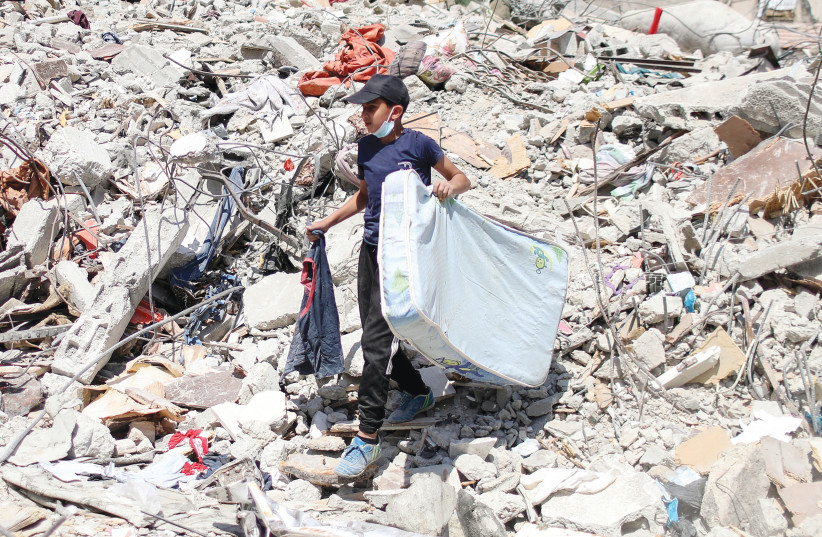
There were active armed conflicts in 39 countries in 2020, an increase of five from the previous year. Sub-Saharan Africa led with 20 armed conflicts, the Middle East and North Africa had seven, Asia and Oceania had seven, and there were two in the Americas.
While the majority of conflicts took place within states, there were two armed conflicts fought between states – India and Pakistan, as well as between Armenia and Azerbaijan for control of Nagorno-Karabakh. There also were armed conflicts between states and groups that aspire for statehood – Israel and the Palestinians in Gaza, as well as between Turkey and the Kurds.
The estimated global number of fatalities decreased for a second year in a row, about 120,000 people, the report found. The war in Afghanistan led to 21,000 fatalities in 2020, making it the deadliest armed conflict in the world. The number of conflict-related deaths in Syria fell below 10,000 in 2020. The fighting between Armenia and Azerbaijan led to an estimated 6,700 military and civilian casualties.
Despite the ongoing conflict between Israel and the Palestinians in the West Bank and Gaza, the number of casualties was at the lowest level in the past decade. According to the IDF, two Israelis, one civilian and one soldier, were killed in 2020. Nine people were killed in 2019, two soldiers and seven civilians, and 16 people were killed in 2018.
Nevertheless, “there still appeared to be little prospect of resolving the underlying Israeli-Palestinian territorial dispute,” the report found.
During Operation Guardian of the Walls, which began in May, 12 Israelis died, one soldier and 11 civilians. The Hamas-run Health Ministry in Gaza said at least 243 Palestinians were killed during the fighting.
Despite a challenging year marked by the global coronavirus pandemic, world military expenditure was estimated to have been almost $2 billion in 2020, 2.6% higher than in 2019 and 9.3% higher than 2011.
Military spending increased in Africa (5.1%), Europe (4%), the Americas (3.9%) and Asia and Oceania (2.5%), the report found.
The number of major arms transfers in 2016-2020 remained almost the same as the previous five years. The five largest arms suppliers – the US, Russia, France, Germany and China – accounted for 76% of total volume of arms exports. The three top suppliers outside of Europe and North America were China, Israel and South Korea.
And while SIPRI could not provide an estimate of total defense spending in the Middle East, Israel brought in $8.3b. in defense exports in 2020. The amount was a 15% increase in the number of agreements signed compared with 2019, which brought in $7.2b., and is the second highest figure after 2017 saw $9.3b.
The global military burden also rose to 2.4% in the last year, making it the biggest increase since the global financial and economic crisis in 2009, the report said. The US increased its military spending for the third straight year to reach $778b. in 2020. China’s military expenditure was estimated at $252b.
With the ongoing coronavirus pandemic, most countries used military assets, especially personnel, to support their responses to the outbreak, and several countries reduced or diverted military spending to address the virus. Those countries included Angola, Brazil, Chile, Kuwait, Russia and South Korea.
The report, which also discussed the global nuclear arsenal, found that despite an overall decrease in the number of nuclear warheads, there has been an increase in the number currently deployed with operational forces.
According to the report, at the start of 2021 there were approximately 13,080 nuclear weapons in the hands of nine states – the US, Russia, the UK, France, China, India, Pakistan, Israel and North Korea – a decrease from 13,400 in 2020 and 13,865 in 2019.
But the number of nuclear weapons deployed with operational forces increased to 3,825 from 3,720. Some 2,000 of them, belonging to Russia or the US, were kept in a state of high operational alert, SIPRI reported.
Both Russia and the US decreased their overall nuclear-weapons stockpiles, but they still collectively account for more than 90% of global nuclear weapons, with 6,255 in Moscow’s arsenal (down from 6,500 in 2020) and the US possessing 5,800 nuclear weapons (down from 6,185 in 2020).
They have also placed an additional 50 nuclear warheads in operational deployment in 2020, with Russia deploying 1,625 and the US 1,800.
The UK was reported to have 225 nuclear warheads (an increase from 215 the previous year), France 290 (down from 300), Israel 90, Pakistan 165, India 156 (up from 150), China 350 (up from 320) and North Korea 40-50.
"conflict" - Google News
June 14, 2021 at 07:54AM
https://ift.tt/2Sq8zto
SIPRI: Number of fatalities caused by armed conflict falls in 2020 - The Jerusalem Post
"conflict" - Google News
https://ift.tt/3bZ36xX
https://ift.tt/3aYn0I8
Bagikan Berita Ini














0 Response to "SIPRI: Number of fatalities caused by armed conflict falls in 2020 - The Jerusalem Post"
Post a Comment